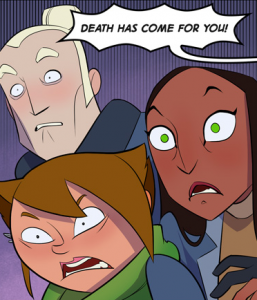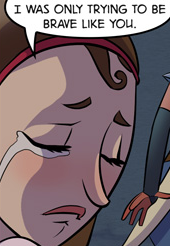I am very lazy, which is why I developed a quick and dirty way to create non-player characters while avoiding as much effort as I can. Some NPCs are created thoroughly before the game, but if I need to create someone during play, I prefer to create as little as possible, adding only what I need, and when I need.
It goes like this:
Step zero: Do I need an NPC here?
 The player characters leave the room without finding the clues; throw in the maid. The PCs stroll through the market and need to have a complication of some sort (because of game mechanics); throw in a street urchin. Occasionally, you need an NPC to do something and get the story moving.
The player characters leave the room without finding the clues; throw in the maid. The PCs stroll through the market and need to have a complication of some sort (because of game mechanics); throw in a street urchin. Occasionally, you need an NPC to do something and get the story moving.
Example: The PCs just destroyed a beast. They’re going to look for some answers now, but I want to keep the tensions high – if they just look around the camp after defeating the beast, I’m losing all of the tension. So instead let’s have someone jump out and shout at them! Let’s say the beast used to have a fiancé, when he was still a man.
Step one: Something physically obvious
 The most basic thing about a person is that they exist, and that they’re different from other people. So this new person should have something unique about them, that is so obvious, it’s part of the initial description I give the players about them.
The most basic thing about a person is that they exist, and that they’re different from other people. So this new person should have something unique about them, that is so obvious, it’s part of the initial description I give the players about them.
Example: I only know she’s a young Bogovian woman with a beast-husband. That’s actually enough, for now: She’ll have tattered rags, because she’s poor and spent a lot of time in the forest lately. I also describe her as having a red hairband, to make her somehow less totally-generic-peasant.
Currently, I still don’t need any rules for her, but in case I do, I’m thinking she’ll be about average in everything (d6), or weaker (d4), because I want her to be completely non-useful in any combat situation.
Step two: A name and a distinct behaviour
 If the players actually speak with the NPC for more than a moment – that is, if they make the NPC a larger part of the story – that NPC then deserves a distinct voice, speech style and body language, or at least one of those. They also need a name, which I can never come up with on the spot, which is why I either ask the players or take one from a pre-made list I keep.
If the players actually speak with the NPC for more than a moment – that is, if they make the NPC a larger part of the story – that NPC then deserves a distinct voice, speech style and body language, or at least one of those. They also need a name, which I can never come up with on the spot, which is why I either ask the players or take one from a pre-made list I keep.
Example: Margaret is the most generic name I can think of for a young peasant woman, so there we go. The players are obviously going to speak with her for a bit, because that’s why she’s here, so I already immediately think about a mannerism for her: Her default emotion is crying, and her default speech style is Ye Olde Butcherede Englishe.
Step three: Something to run from, and something to run toward
 If the NPC is becoming an important part of the game – such as being brought again into the next scene, or beyond – they now deserve layers. The easiest and laziest way to give layers, is to create two conflicting motivations for them: Something they run from, trying to avoid, leave behind, or ignore; and something they run toward, that they want to have or to become. These can be quite simple, they just need to exist, so I can roleplay the character as having more than just what you see in face value.
If the NPC is becoming an important part of the game – such as being brought again into the next scene, or beyond – they now deserve layers. The easiest and laziest way to give layers, is to create two conflicting motivations for them: Something they run from, trying to avoid, leave behind, or ignore; and something they run toward, that they want to have or to become. These can be quite simple, they just need to exist, so I can roleplay the character as having more than just what you see in face value.
The NPC also now deserves a variation on their archetype, whatever it is (elf, poor peasant, beautiful princess). The archetype can be emphasized (he’s a really snobbish elf), covering some other archetype (the poor peasant is also an old war veteran), or subverted (the beautiful princess is actually using magic to cover her scars).
One last thing is recomended as well: Adding a question mark to rouse the players’ interest. This should come in one of two places: Either where the NPC connects with the world (she seems to be avoiding the main streets of the city, I wonder why?) or where they connect with one of the PCs background (as an ex-con, you notice he walks in a strange fashion, as if he’s hiding several small items under his clothes).
Example: The moment I realise Margaret is with them when they descend into the catacombs, I need to give her the full step three treatment. Something to run from: The pain of the past. Something to run toward: Seek justice for her Hans. The both are kinda similar, but that’s fine, at least for now. I also enhance her archetype in some way – for a Bogovian peasant she’s really Bogovian, having lots of fighting spirit – and as for the question mark, I push that away for now, since we’re in the middle of a fight and there’s enough action going around anyway.
Rules-wise, I decide to giver her Fighting d4, for being so feisty, and probably even an Edge of some kind, perhaps Brave (seeing as she made the Fear check).
Final note: If you understand Hebrew, check out the podcast episode we did on this subject, Creating Interesting NPCs, in which we elaborate on several similar quick-and-dirty methods.



